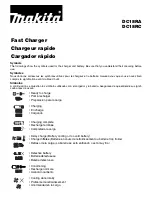
22 | SAMLEX AMERICA INC.
SAMLEX AMERICA INC. | 23
1.4.12 Depth of Discharge of Battery and Battery Life
The more deeply a battery is discharged on each cycle, the shorter the battery life. Using more
batteries than the minimum required will result in longer life for the battery bank. A typical cycle
life chart is given in the Table 1.12 below:
TABLE 1.12 TYPICAL CYCLE LIFE CHART
Depth of Discharge
% of Ah Capacity
Cycle Life of Group
27 /31
Cycle Life of Group
8D
Cycle Life of Group
GC2
10
1000
1500
3800
50
320
480
1100
80
200
300
675
100
150
225
550
NOTE:
It is recommended that the depth of discharge should be limited to 50%.
1.4.13 Series and Parallel Connection of Batteries
Refer to details at Section 3.4.
1.4.14 Sizing the Inverter Battery Bank
One of the most frequently asked questions is, “how long will the batteries last?” This question
cannot be answered without knowing the size of the battery system and the load on the
inverter. Usually this question is turned around to ask “How long do you want your load to
run?”, and then specific calculation can be done to determine the proper battery bank size.
There are a few basic formulae and estimation rules that are used:
1. Active Power in Watts (W) = Voltage in Volts (V) x Current in Amperes (A) x Power Factor
2. For an inverter running from a 12V battery system, the approximate DC current required
from the 12V batteries is the AC power delivered by the inverter to the load in Watts (W)
divided by 10 & for an inverter running from a 24V battery system, the approximate DC
current required from the 24V batteries is the AC power delivered by the inverter to the
load in Watts (W) divided by 20.
3. Energy required from the battery = DC current to be delivered (A) x Time in Hours (H).
The first step is to estimate the total AC watts (W) of load(s) and for how long the load(s) will
operate in hours (H). The AC watts are normally indicated in the electrical nameplate for each
appliance or equipment. In case AC watts (W) are not indicated, Formula 1 given above may be
used to calculate the AC watts. The next step is to estimate the DC current in Amperes (A) from
the AC watts as per Formula 2 above. An example of this calculation for a 12V inverter is given
below:
Let us say that the total AC Watts delivered by the inverter = 1000W.
Then, using Formula 2 above, the approximate DC current to be delivered by the 12V batteries
= 1000W ÷10 = 100 Amperes, or by 24V batteries = 1000W ÷ 20 = 50A.
Next, the energy required by the load in Ampere Hours (Ah) is determined
.
For example, if the load is to operate for 3 hours then as per Formula 3 above, the energy to be
delivered by the 12V batteries = 100 Amperes × 3 Hours = 300 Ampere Hours (Ah), or by the
24V batteries = 50A x 3 Hrs = 150 Ah.
SECTION 1 |
Safety Instructions & General Information
Summary of Contents for Evolution EVO-1212F
Page 109: ...SAMLEX AMERICA INC 109 Notes...
Page 110: ...110 SAMLEX AMERICA INC Notes...
Page 111: ...SAMLEX AMERICA INC 111 Notes...
















































